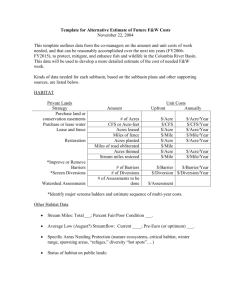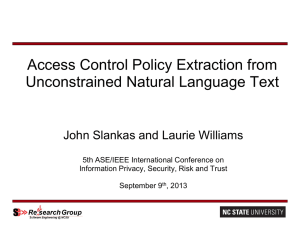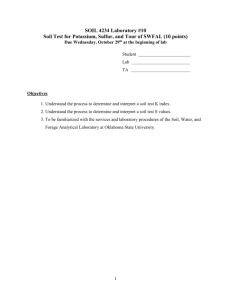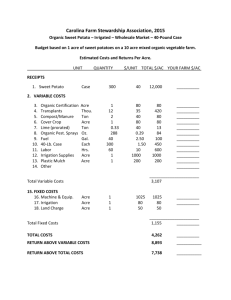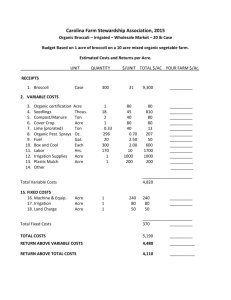Extension Demonstrations/Projects 2012 St. Francis
advertisement
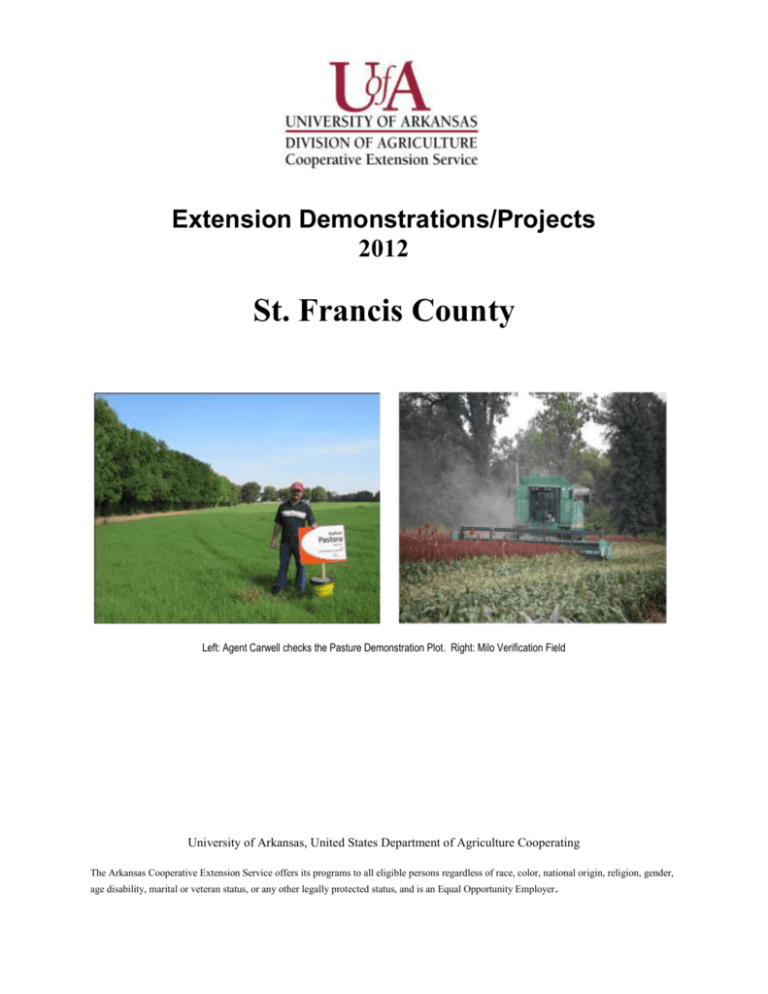
Extension Demonstrations/Projects 2012 St. Francis County Left: Agent Carwell checks the Pasture Demonstration Plot. Right: Milo Verification Field University of Arkansas, United States Department of Agriculture Cooperating The Arkansas Cooperative Extension Service offers its programs to all eligible persons regardless of race, color, national origin, religion, gender, age disability, marital or veteran status, or any other legally protected status, and is an Equal Opportunity Employer. St. Francis County RICE VARIETY TRIAL Cooperator: Byron Holmes and RiceTec County Agents: Mitch Crow and David Carwell Purpose of Demonstration: To compare conventional rice varieties with hybrid rice varieties. Hybrid rice varieties seed and urea requirements place additional input costs on the producer. Impact: Today’s high grain prices competing for land, it is imperative that rice is still grown in the state. Rice acreage has been declining over the past few years with increasing acres going toward corn production. Location: Forrest City Soil Type: Calloway Silt Loam Previous Crop: Soybeans Seeding Rate: Hybrids = 22.5 lbs/acre, Conventional varieties = 70 lbs/acre Fertilizer: 30 lbs Zinc Sulfate and 100 lbs 0-60-90 at planting. 50 lbs Ammonium Sulfate and 200 lbs Urea at flush. 150 lbs of urea was applied at midseason. Herbicide: Pre-Emergence: 8/10 pint Command. Post Emergence: 1 gal propanil and 1 oz Permit/Ac. Midseason levees sprayed with Aim and Stam. Harvested: Hybrid, 9/6/12. Conventional, 9/19/2012 Replications: 2 Variety Moisture Length Width Wet Yield (bu/ac) Dry Yield (bu/ac) Wells 17.1 786 25 199.4 188.7 Cheniere 16.3 786 25 195.0 185.0 Taggart 18.3 792 25 197.1 183.9 Roy J 17.2 786 25 218 206 Templeton 17.8 789 25 195.1 183.3 XL723 15.9 783 25 223 212.8 XP753 15.6 783 25 232.2 222.5 XP761 15.6 783 25 208 200 St. Francis County N-ST*R TRIAL Cooperator: Ron Hall County Agents: Mitch Crow and David Carwell Purpose of Demonstration: The rising input costs on urea in combination with the weak prices for rice have limited the amount of rice presently being grown. The N-ST*R soil sample test is a new technique developed by the University of Arkansas. This techniques requires soil samples be taken from 18 inches deep instead of the traditional 4-6 inches. The purpose of this technique is to get the total nitrogen amount right on a per field basis. Impact: The amount of nitrogen fertilizer being applied is starting to have some effect on water quality issues. The potential impact of implementing this technique is that the producer can lower the total amount of nitrogen fertilizer being applied while still producing a yield comparable to the traditional fertilization methods. Location: North of Palestine Variety: CL 111 Soil Type: Calloway and Henry Silt Loam Previous Crop: Soybeans Seeding Rate: 80 lbs/acre Planting Date: 3/30/2012 Harvest Date: 8/23/2012 Additional Fertilizer: 60 lbs Phosphorus/acre and 90 lbs Potash/acre Irrigation: Flood Herbicide: Post Emergence, Newpath 4 oz/acre (2 applications), Strada Pro (1 pint/acre). Fungicide: Quadris (1 gal/16 acres) Treatment Total N Rate (units N/acre) Dry Weight (bu/acre) Net Returns to N-1 ($/acre) Net Returns to N-2 ($/acre) Traditional Prac. 150 172 1107 1074 N-ST*R 165 190 1223 1187 N-1 represents urea prices at $600/ton and a rough rice price of $7.00/bu. N-2 represents urea prices at $800/ton and a rough rice price of 7.00/bu. St. Francis County Cooperator: SOYBEAN VARIETY TRIAL Chris Roberts County Agents: David Carwell and Mitch Crow Purpose of Demonstration: The rising commodity prices of soybeans have sparked interest in more soybean acreage. This variety demo was implemented to demonstrated some of the ‘’higher yield’’ varieties available to producers. Impact: Increase yield in soybeans is the driving force of maintaining profitability for today’s farmers. Nine strip plots were planted on the Roberts farm. The highest yielding variety averaged 76 bu/ac with the lowest yielding variety averaging 65 bu/ac. The overall average of all the plots was 70 bu/ac. Planted: 4/18/2012 Soil Type: Earle Clay Previous Crop: Corn (Irrigated) Seeding Rate: 180,000 Row Spacing: 15 inches Fertilizer: None Herbicide: Burndown = 32 oz/acre Touchdown and 2 oz/acre Valor, Planting = 48 oz/acre Sequence, PostEmergence = 32 oz/acre Touchdown, 8 oz/acre Python and 3/10 oz/acre FirstRate Irrigation: Center Pivot, 14 times at 1’’ each Harvested: 9-12-2012 Brand Variety Yield (Bu/Ac) Moisture Plot Length (ft) Width (in) Test Weight Pioneer 94Y40 65.8 12.1 1230 225 53.6 Schillinger SCH 457 68.3 12.9 1230 225 55.5 Progeny 4510 66.6 12.1 1230 225 55.7 Armor 46R64 72 12.4 1230 225 55.9 Asgrow 4632 76.2 12.4 1230 225 53 Progeny 4710 75.7 12.0 1230 225 54.7 Pioneer 94Y70 69.4 12.3 1230 225 53.9 Armor 48R40 71.2 11.8 1230 225 54.9 Schillinger SCH 495 71.1 13.1 1230 225 53.9 St. Francis County BERMUDA GRASS VARIETY TRIAL Cooperator: Margy Cannon County Agent: David Carwell Purpose of Demonstration: Forage is the key to maintaining a successful cow herd. The amount of hay you can produce can be the deciding factor on how you manage your herd for that year. Drought conditions in several states over the past few years have also boosted the hay market allowing producers to sell their excess hay to cut down on expenses. Impact: By determining the top yielding forage, we are able to select which variety is most suitable for the region. Additionally, we can also determine drought and cold tolerance, fertilization capacity and palatability when fed at a later date. Location: Forrest City Soil Type: Loring Silt Loam Fertilizer: Prior to 1st cutting, 150 lbs urea and 100 lbs 0-0-60. Prior to second cutting, 100 lbs of urea. Herbicide: 1 oz Pastora/ac (spot spray application) Number of Cuttings: 3 Variety Cutting 1 2 3 Ton/Acre 0.7 2.4 0.4 Wrangler 1 2 3 1.3 2.2 0.4 3.9 Midland 99 1 2 3 2.2 2.2 2.2 6.5 Tifton 44 1 2 3 2.4 2.8 1.5 6.8 World Feeder Total Ton/Acre 3.5 St. Francis County GRAIN SORGHUM VERIFICATION TRIAL Cooperator: Sid Fogg County Agents: Mitch Crow and David Carwell Purpose of Demonstration: The heavy use of Roundup and other generic glysophates has led to an increase in resistant weeds. By using crop rotation and growing specific crops, substitute herbicides can be used to control glysophate resistant weeds. Impact: Higher demand, strong prices and a good dryland crop make grain sorghum a good candidate for pigweed problem fields. Location: Widener Planted: 4/12/2012 Previous Crop: Soybeans Seeding Rate: 70,000 Row Spacing: 19 inches Fertilizer: 240 lbs of urea at pre-emergence Herbicide: Preplant =1.5 pints/acre Parallel, 32 oz/acre Touchdown, Post-emergence =1.3 quarts/acre Atrazine + oil. Irrigation: None Harvested: 7/30/2012 Yield: 92 bu/acre St. Francis County CORN VARIETY TRIAL Cooperator: Nathan Brown County Agent: Mitch Crow Purpose of Demonstration: Corn hybrid seed selection is a very important management decision for a successful corn producer. Yield potential is critically important, however, additional characteristics to consider are lodging, disease reaction, ear shuck cover and ear flexing. Impact: The variety trial was conducted to show producers a wide range of varieties available in the area that can be grown. The high prices for corn in today’s market demand the highest producing varieties with the above characteristic mentioned. Location: Wheatley Soil Type: Loring Silt Loam Previous Crop: Soybeans Row Width: 30 inches Planting Population: 36,000 Planting Date: 4/6/2012 Harvest Date: 8/18/2012 Irrigation: Furrow (8 times) Fertility (lb/ac) N P K S Zn Preplant 80 80 100 10 1 In-season 117 8 4 0 0.5 Pretassel 53 0 0 0 0 Total 250 88 104 10 1.5 Armor 1262 DPRO Adjusted Yield bu/ac1 175.0 Harvest Moisture 18.9% Plant Stand2 36,000 Lodging Score3 1 Test Weight lb/bu 53.0 Armor 1550 DPRO 197.8 19.5% 35,000 1 55.5 B-H 8845 VTTP 183.5 19.6% 37,000 1 55.0 B-H 8570 VTTP 190.0 19.6% 38,000 1 53.5 Golden Acres 26V21 207.8 20.5% 34,000 1 53.0 Golden Acres 27V01 198.0 21.8% 36,000 1 49.0 Pioneer P1745HR 199.5 19.1% 34,000 1 47.5 Pioneer 2088YHR 187.8 18.2% 35,500 1 54.0 Terral REV 26HR50 163.8 18.3% 35,000 1 53.5 Terral REV 28HR20 165.2 18.4% 35,000 1 57.0 Hybrid 1 Yield is adjusted to 15.5% moisture Plant Stand is given as plants per acre 3 Lodging Score – 1 is no lodging, 10 is completely lodged 2 St. Francis County COTTON VARIETY TRIAL Cooperator: Joe Whittenton County Agent: Mitch Crow Purpose of Demonstration: Cotton was once “king” of all commodities grown in eastern Arkansas. The decline in cotton grown began to come back to life in the 1960’s. A large number of producers still grow cotton in St. Francis County. To remain profitable, top yields must be achieved. Impact: Producers must increase yields. Economists have historically said that producers must produce 1000 lb/acre to break even. The ten varieties in the trial averaged 1040 lb/acre. Seven of the varieties produced over 1000 lb/acre. The highest yielding variety was ST 5288 producing 1251 lb/acre. Location: Forrest City Soil Type: Loring Silt Loam Irrigation: Center Pivot Row Width: 38 inches Planting Date: 5/8/12 Harvest Date: 11/7/12 Fertility (lb/ac) Preplant N P K S 0 22 60 19 In-season 125 0 60 0 Total Fertility 125 22 120 19 Variety Lint Yield Lint Percent Mic Staple Strength Uniformity Value Stoneville 5288 B2F 1251.9 34.52 5 36 27.9 81.9 637.84 FiberMax 1944 GLB2 1107.63 33.84 5.1 39 32.7 83.3 578.74 Phytogen 375 WRF 1090.34 36.14 5.2 34 27 79 541.9 Stoneville 5458 B2RF 1078.89 34.04 5.3 37 31.2 82.1 543.76 Dyna-Gro 2570 B2RF 1066.07 35.94 5.2 36 29 82.4 552.22 Deltapine 0912 B2RF 1046.89 34.23 5.2 36 29.4 82.1 535.48 Phytogen 499 WRF 1046.54 36.54 5 36 32.4 83.3 539.49 NexGen 1511 B2RF 952.96 37.54 5.1 36 29.7 82.6 487.44 Deltapine 1219 B2RF 888.14 33.81 4.8 38 35.3 83.5 479.15 Deltapine 1133 B2RF 874.35 36.98 5.1 36 31.4 83 456.41 St. Francis County COTTON RESEARCH VERIFICATION TRIAL Cooperator: Caleb Jones Agents: Mitch Crow and David Carwell Purpose of Demonstration: The CRVP is an on-farm demonstration of all the research-based recommendations to grow cotton in Arkansas. The demonstration verifies that researched-based recommendations are profitable. It develops a database for economic analysis for cotton production and promotes timely implementation of cultural and management practices. It also provides training and assistance to county agents new to cotton production, as a cotton verification coordinator scouts the field each week to monitor for pest, irrigation and growth regulator applications. Impact: Final Summary of Revenue and Expenses are still being tabulated. But the St. Francis County Cotton Verification is compared to overall 2012 CRVP averages across Arkansas. The St. Francis County trial had a $75.39 (average) economic advantage over other CRVP fields in Arkansas. 53 Acre Field near Palestine Lint Yield: 1215 lbs/ac Fertility: 91-46-105-12 (N-P-K-S) Herbicide Applications: Dicamba + Touchdown at Burndown Roundup Powermax + Warrant Roundup Powermax + Warrant Insecticide Applications: Radiant Carbine Centric Tundra + EpiMek Acephate St. Francis County Vs. 2012 CRVP Average St. Francis County 2012 CRVP Average Difference Operating Costs 534.44 514.46 19.98 Total Costs 636.63 601.06 35.57 Returns to Total Costs 238.17 98.35 139.82 0.52 0.55 -0.03 874.80 799.41 75.39 Total Costs/Pound Total Crop1 Revenue Crop Revenue was derived using the Arkansas Average based on the USDA January 2013 Market News Report St. Francis County MOTH TRAPPING PROGRAM Agent: Mitch Crow Purpose of Demonstration: The bollworm has historically been one of the most destructive pests of cotton. The newer transgenic cotton varieties, Bollguard II and Widestrick, have two Bt genes in their plants. But even these varieties are not immune to the bollworm. Pheremone traps use the female moths' hormone, or scent, to lure their male counterpart to a moth trap. The male moth flies into the bottom of the trap and is caught in the top, removable part of the wire basket-type trap. By monitoring the number of moths caught over a period of time, large moth flights can be determined and consultants and growers can treat small bollworm larvae as soon as the egg hatches. Impact: Nine bollworm moth traps were monitored twice per week—each Tuesday and Friday—from June until late August. Traps were located across the county, from Shell Lake to Palestine. Most of the traps were on either side of Crowley's Ridge where most of our county's cotton is grown. It seems that traps that were located near corn fields caught more moths, and moth trap number fluctuated during the trapping period. During the second week of July, moth trap numbers peaked. Our county's cotton was planted earlier this year. Probably two-thirds of cotton acres were at cut-out node above white flower-5 at second week in July. Only isolated fields of cotton were treated this year. Maybe 25% of acres in county were treated for bollworm larvae. The trap at Shell Lake--Delta Terre--was located in an area where soybean and rice are grown. The clay soil in this part of the county is not good to grow cotton on. Consultant Russell Simon at Blackfish, helped with this trap. JUNE (checked 6x) TRAP LOCATION High Cottonwood Corner Low JULY (checked 8X) Avg. High Low AUGUST (checked 8x) Avg. High Low AVG/TRAP Avg. 9 0 4 144 20 98 165 21 56 52 Madison 29 1 11 110 16 68 215 27 79 35 Linden Island 43 2 18 53 22 44 78 9 26 29 SFC 739 Haven 35 12 20 279 43 199 214 5 94 74 Yocona Rd 21 3 7 277 0 85 256 14 145 79 Caldwell 14 0 6 153 9 68 110 15 46 40 SFC 255 Weeks 19 0 6 114 10 51 185 35 85 83 SFC 858 64 2 18 238 22 146 158 28 71 78 Delta Terre 45 24 31 231 0 69 116 18 67 56
